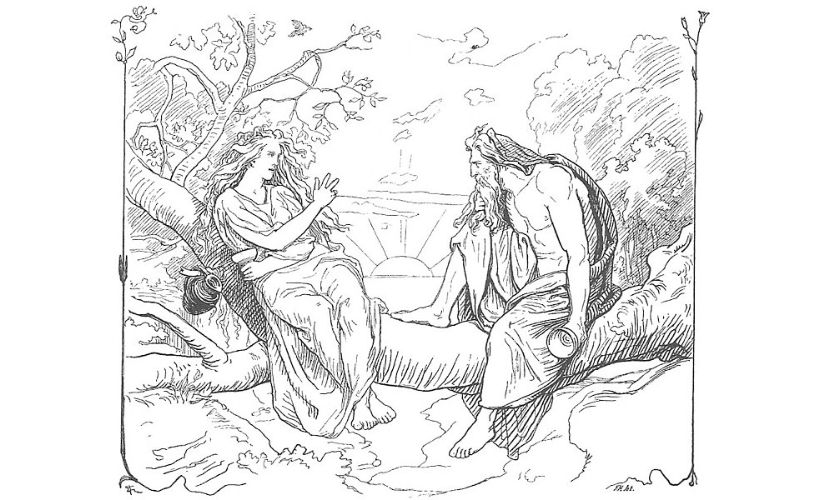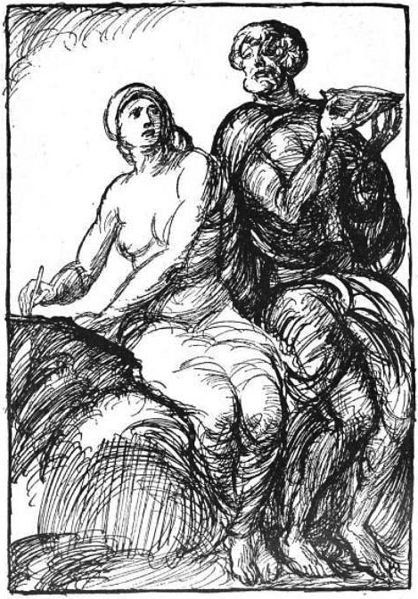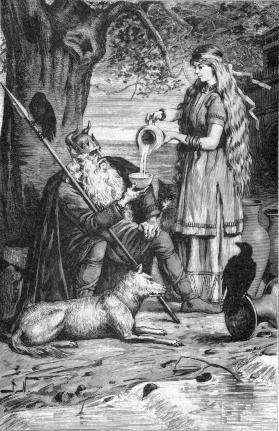In the intricate web of Norse mythology, Sága and her residence, Sökkvabekkr, emerge as entities enveloped in enigma and fascination. As we journey through this narrative, we’ll unravel the tales and truths surrounding this captivating goddess and the mystical dwelling she calls home.
Sága Key Facts
| Parents | Unknown |
| Partners | None known |
| Siblings | Not specified |
| Offspring | None |
| Tribe | Aesir |
| Old Norse name | Sága |
| Other names | None |
| The God of | Seeress, history, and storytelling |
| Home or hall | Sökkvabekkr |
Name and Etymology
Sága, in Old Norse, is a name that echoes with tales and narratives. The etymology of her name is intrinsically tied to the Old Norse word “saga,” which translates to “story” or “tale.” This association underscores her role as a seeress and a storyteller, safeguarding the chronicles and tales of the gods. Kennings, those poetic metaphors found in Norse poetry, often refer to Sága as the “seeress of the gods” or the “guardian of ancient tales.”

Sökkvabekkr, on the other hand, is a name that evokes images of serene, flowing waters. In Old Norse, “sökkva” means “to sink” or “submerge,” and “bekkr” translates to “stream” or “brook.” Together, the name paints a picture of a submerged or underwater stream, hinting at the tranquil and mysterious nature of Sága’s dwelling.
Meaning of Sökkvabekkr
I have seen a lot of mentions of the possible etymology for Sökkvabekkr. In one, people are focused on another possible meaning, understanding it as meaning ‘sunken bench’, or ‘sunken bank’. To me this makes little sense. The more reasonable understanding of the etymology is that *bekkr comes from the Proto-Germanic *bakiz. This translate to brook, or creek.
Furthermore, a ‘bekk’ in Norwegian is just that, a small creek. Why Odin and Sága should sit everyday and drink by a sunken bench, when the other alternative is that they sit by a sunken/hidden creek is beyond me.
Ancient roots
Sága’s name has deep roots in Norse traditions, but it’s fascinating to think that her origins might predate the Norse myths. Some scholars suggest a connection to ancient Germanic traditions, which highly valued storytelling and history-keeping. However, despite attempts to find them, direct links to Gothic or Roman mythologies remain out of reach, solidifying her status primarily as a figure of Norse lore.
Sága’s Genealogy
The origins of Sága remain enigmatic. Unlike many other gods and goddesses in Norse mythology, ancient texts do not explicitly detail her parentage and early life. This absence of a clear lineage adds to her mysterious aura. Some sources suggest she might be a daughter of Odin, the Allfather, however this claim is not universally accepted. Her birth, too, remains a topic of speculation, with no specific tales recounting the circumstances of her arrival in the world of gods.
Family and Relationships
Sága’s relationships, much like other aspects of her life, are not extensively documented. The most notable connection she has is with Odin. In the poetic edda, they are described sharing drinks and tales by the Sökkvabekkr every day. This close association with the chief god suggests a bond of mutual respect and camaraderie.
Children
There are no known offspring of Sága in the Norse myths. Her role seems more focused on preserving stories than on familial ties.
Sága’s Roles, Responsibilities, and Depiction
Sága actively plays a central role in the Norse gods’ pantheon due to her expertise as a seeress and storyteller. She stands out among the gods as the keeper of histories, preserving tales of their deeds, both grand and trivial, for future generations. For humans, she represents the significance of history and the potency of stories. Moreover, her stories offer insights, morals, and lessons, guiding mortals in their endeavors.

Her close association with stories and history paints a picture of a goddess who values knowledge and understanding. While she might not be at the forefront of battles or grand adventures, her role is crucial in preserving the legacy of the gods. Her demeanor is calm, and she’s often visualized in serene settings, reflecting her introspective nature.
Sága’s dwelling, Sökkvabekkr, is a place of serene beauty, characterized by its flowing brook, which might be partially hidden or sunken in the landscape. This tranquil setting, where stories seem to flow like the waters of the brook, draws a parallel with Mimir’s well. Odin, in his pursuit of wisdom, drank from Mimir’s well, acquiring unparalleled insight. In a similar vein, his visits to Sága at Sökkvabekkr appear to grant him a profound understanding of ancient tales and histories. The comparison between Sága’s brook and Mimir’s well underscores the significance the Norse placed on knowledge, whether acquired through wisdom or recounted tales.
Play Fun Norse Quiz
Is this article making you even more curious about Norse gods and goddesses? You can satisfy your curiosity by playing a fun Norse mythology quiz. This way, you can test your knowledge about Norse gods and goddesses, as well as fill in some gaps. Good luck and have fun playing!
Don’t forget to try our other games as well!
The Value of Oral Tradition to the Vikings
For the Vikings, the art of storytelling was not merely a pastime; it was a lifeline to their past, a bridge to their ancestors, and a guide for their present and future. In an era where written records were sparse, the oral tradition was the primary means of preserving history, culture, and collective wisdom. Every tale told and retold was a thread in the intricate tapestry of their shared heritage.
The Vikings lived in a world where nature was both an ally and an adversary, where gods and giants walked among men, and where fate was an ever-present force. In such a world, the stories of old served multiple purposes. They were lessons in courage, cautionary tales of hubris, and reminders of the values and virtues that the Norse held dear. These tales, passed down from generation to generation, helped shape the Viking worldview and provided a moral compass for a people often navigating uncharted waters.
Moreover, the act of storytelling was a communal event. It brought together families and clans, young and old, around roaring fires under starlit skies. The skalds, or poets, held a revered place in Viking society. With their lyrical prowess, they could evoke emotions, impart wisdom, and transport listeners to realms of gods, monsters, and heroes. In a society that valued honor, bravery, and loyalty, these tales reinforced these ideals and celebrated those who embodied them.
Saga’s role
In this context, Sága’s role as the keeper of stories becomes even more significant. Her brook, Sökkvabekkr, might be seen as a metaphorical representation of the continuous flow of stories and knowledge. Just as Odin sought wisdom and insight from both Mimir’s well and Sága’s tales, the Vikings, too, turned to their stories as sources of wisdom, guidance, and inspiration. For them, remembering and recounting the old tales was not just about preserving history; it was about understanding their place in the world and drawing strength from the deeds and lessons of their forebears.
Myths about Sága
Sága’s myths primarily revolve around her interactions with other gods, especially Odin. One of the most notable tales describes Odin visiting her in her underwater dwelling, where they share drinks from golden cups and exchange stories. This tale underscores her importance as a keeper of histories and her close bond with the Allfather.
Mentions in Ancient Texts
Poetic Edda
Grímnismál
In the Grímnismál, Sökkvabekkr is highlighted as one of the significant residences of the gods. The poem portrays Odin (in the guise of Grímnir) enlightening the young Agnar about the various abodes of the deities. Odin describes how he and Sága partake in joyful drinking sessions at Sökkvabekkr, with the waves creating a harmonious backdrop.
“Sökkvabekk is the fourth, where cool waves flow, And amid their murmur it stands; There daily do Othin and Saga drink In gladness from cups of gold.”
Helgakviða Hundingsbana I
In the Helgakviða Hundingsbana I, the hero Sinfjötli makes a reference to Sága when mentioning a location during a stanza where he engages in a poetic contest with Guðmundr. The place, termed as “nes Ságu,” has been translated in various ways, such as “Saga’s Headland,” “Saga’s Cape,” and “Saga’s ness.” It’s worth noting that part of this stanza might be missing, leading some editors to combine it with the preceding stanza.
Prose Edda
Gylfaginning
Both Sága and Sokkvabekk receive mentions in the Gylfaginning. In Chapter 35, High converses with Gangleri (who is described as King Gylfi in disguise) about the ásynjur (goddesses). After describing Frigg and her dwelling, Fensalir, High mentions,
“Second is Saga. She dwells in Sokkvabekk, and that is a big place.”
Skáldskaparmál
In the Skáldskaparmál, Sága is listed among 27 ásynjur. However, this section does not delve into details about her, merely acknowledging her presence in the pantheon of goddesses.
Frequently Asked Questions
Sága is revered as a seeress and the keeper of stories and histories in Norse mythology.
Sága shares a close bond with Odin, and they are often depicted sharing tales in her underwater dwelling.
No, there are no known children of Sága in Norse myths.
One of the most prominent tales involves Odin visiting her and the two sharing stories over drinks.
Sága’s role in Ragnarok remains ambiguous, with no specific details provided in ancient texts.
Featured Image Credit: Lorenz Frølich, Public domain, via Wikimedia Commons

